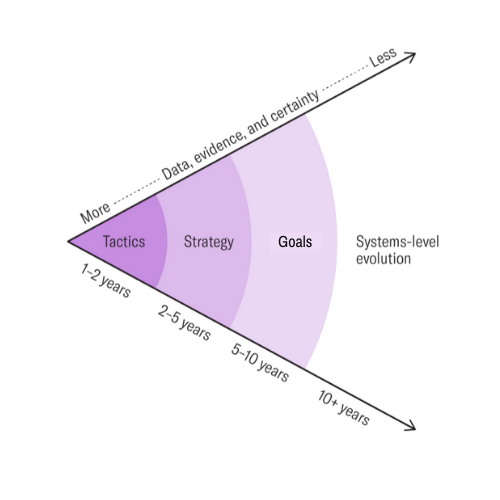By Molly Penn
Reflecting on all the work we do with incredible clients, and the many, many conversations we have with prospective clients, I find myself noticing some natural tension points that arise as we try to move away from transactional relationships towards more transformative ones. Here are some examples as food for thought and continued dialogue.
Aspiration vs. measurability
This shows up in a number of ways. Some clients tell us they want to make sure their strategic plan is measurable. There is a whole school of thought that “what gets measured gets managed” – we get it. What we often tell strategic planning clients who ask that their strategy be measurable is that if you aspire to do something big and bold (like systems change), there are going to be aspects of that change that you don’t control, or that may shift around you. If you really want something to be measurable, it has to be something you alone control (which by nature limits the level of aspiration) and that is predictable. The dictionary definition of aspiration is “a strong desire to achieve something high or great” and it gives the example “an aspiration to become famous.” Aspiration, by its nature is not certain and it is not entirely within our control. So the level of aspiration in your plan will naturally be constrained if you seek measurability. Discerning where you fall on this continuum is an important discussion to have at the outset of a strategic planning process.
Tolerating messiness
Clients want their consultants to project confidence, clarity and certainty. At the same time, they don’t want “cookie cutter” processes where they feel they are being put into someone else’s model. In aiming for transformational vs. transactional work, we are not doing our job if we don’t surface some provocative questions that don’t have easy answers, or discover insights that may hold tremendous promise for our clients. That can mean slowing down to delve a bit more into those provocative ideas to see if they can be applied to the client’s unique situation. Often, this feels “messy” to clients, like we’re going off schedule, or not sticking to the plan. For us, the unpredictable is where we feel we can add the most value in transformational work. If you just want a transaction, you can get a cookie cutter solution. It is important to realize that a consultant who proposes a plan will either follow that plan religiously and deliver a predictable result or will follow interesting leads that get surfaced and possibly deliver a transformative result – which would you want?
In the book Future Good, by Trista Harris, she talks about the challenge of planning for an uncertain future. There is an image that describes some of what we are talking about:

We have come to realize that, in order to do real change work, we need to spend time encouraging our clients to tolerate complexity. Real change involves interrogating our mental models, tapping into human creativity, and navigating complexity in order to land on a transformative solution. These are not linear processes, they are deeply human processes. Being transformational is about the marriage of aspiration and intention, inspiration and effort. Transformation is about creating deep and positive change, and that may require a little good trouble..
We hope that we can all find the space to navigate complexity with greater facility – to surf the changes in the world around us, rather than fight them. To see where the changing tides take us and what stones they overturn that hold new promise for the people we serve.

